Development of Apoptotic-Cell-Inspired Antibody–Drug Conjugate for Effective Immune Modulation
Abstract
:1. Introduction
2. Results and Discussion
2.1. Synthesis of p(HEMA-co-MPS)
2.2. Conjugation of Goat Anti-Mouse IgG with p(HEMA-co-MPS)
2.3. Antibody-Binding Affinity after Conjugation with p(HEMA-co-MPS)
2.4. Cell Viability and Anti-Inflammatory Effect of p(HEMA-co-MPS)
2.5. Anti-Inflammatory Effect of IgG-p(HEMA-co-MPS)
3. Materials and Methods
3.1. Materials
3.2. Synthesis of MPS Monomer
3.3. Synthesis of p(HEMA-co-MPS)
3.4. Fabrication of IgG-p(HEMA-co-MPS)
3.5. Measurement of the Binding Affinity
3.6. Cytotoxicity and Anti-Inflammatory Potential Evaluation
3.7. Statistical Analysis
4. Conclusions
Supplementary Materials
Author Contributions
Funding
Data Availability Statement
Acknowledgments
Conflicts of Interest
References
- Abuhelwa, Z.; Alloghbi, A.; Nagasaka, M. A comprehensive review on antibody-drug conjugates (ADCs) in the treatment landscape of non-small cell lung cancer (NSCLC). Cancer Treat. Rev. 2022, 106, 102393. [Google Scholar] [CrossRef]
- Pal, L.B.; Bule, P.; Khan, W. An Overview of the Development and Preclinical Evaluation of Antibody–Drug Conjugates for Non-Oncological Applications. Pharmaceutics 2023, 15, 1–19. [Google Scholar] [CrossRef] [PubMed]
- Ibtehaj, N.; Huda, R. High-dose BAFF receptor specific mAb-siRNA conjugate generates Fas-expressing B cells in lymph nodes and high-affinity serum autoantibody in a myasthenia mouse model. Clin. Immunol. 2017, 176, 122–130. [Google Scholar] [CrossRef] [PubMed]
- Zhou, C.; Lehar, S.; Gutierrez, J.; Rosenberger, C.M.; Ljumanovic, N.; Dinoso, J.; Koppada, N.; Hong, K.; Baruch, A.; Carrasco-Triguero, M.; et al. Pharmacokinetics and pharmacodynamics of DSTA4637A: A novel THIOMAB™ antibody antibiotic conjugate against Staphylococcus aureus in mice. mAbs 2016, 8, 1612–1619. [Google Scholar] [CrossRef]
- Kvirkvelia, N.; McMenamin, M.; Gutierrez, V.I.; Lasareishvili, B.; Madaio, M.P. Human anti-α3 (IV) NC1 antibody drug conjugates target glomeruli to resolve nephritis. Am. J. Physiol. Ren. Physiol. 2015, 309, F680–F684. [Google Scholar] [CrossRef] [PubMed]
- Lee, H.; Bhang, S.H.; Lee, J.H.; Kim, H.; Hahn, S.K. Tocilizumab–alendronate conjugate for treatment of rheumatoid arthritis. Bioconjugate Chem. 2017, 28, 1084–1092. [Google Scholar] [CrossRef] [PubMed]
- Lim, R.K.V.; Yu, S.; Cheng, B.; Li, S.; Kim, N.J.; Cao, Y.; Chi, V.; Kim, J.Y.; Chatterjee, A.K.; Schultz, P.G.; et al. Targeted delivery of LXR agonist using a site-specific antibody–drug conjugate. Bioconjugate Chem. 2015, 26, 2216–2222. [Google Scholar] [CrossRef] [PubMed]
- Buttgereit, F.; Aelion, J.; Rojkovich, B.; Zubrzycka-Sienkiewicz, A.; Chen, S.; Yang, Y.; Arikan, D.; D’Cunha, R.; Pang, Y.; Kupper, H.; et al. Efficacy and Safety of ABBV-3373, a Novel Anti–Tumor Necrosis Factor Glucocorticoid Receptor Modulator Antibody–Drug Conjugate, in Adults with Moderate-to-Severe Rheumatoid Arthritis Despite Methotrexate Therapy: A Randomized, Double-Blind, Active-Controlled Proof-of-Concept Phase Iia Trial. Arthritis Rheumatol. 2023, 75, 879–889. [Google Scholar] [PubMed]
- Lim, J.; Lewin-Koh, N.; Chu, T.; Rymut, S.M.; Berhanu, A.; Carrasco-Triguero, M.; Rosenberger, C.C.; Hazenbos, W.L.; Miller, L.G.; Fowler, J.V.G.; et al. 168. Efficacy of the Novel gwt1 Inhibitor APX2039 in a Rabbit Model of cryptococcus Meningitis. Open Forum Infect. Dis. 2020, 7, S213. [Google Scholar] [CrossRef]
- Peck, M.; Rothenberg, M.E.; Deng, R.; Lewin-Koh, N.; She, G.; Kamath, A.V.; Carrasco-Triguero, M.; Saad, O.; Castro, A.; Teufel, L.; et al. Preclinical and translational pharmacokinetics of a novel THIOMAB™ antibody-antibiotic conjugate against Staphylococcus aureus. Antimicrob. Agents Chemother. 2019, 63, e02588-18. [Google Scholar]
- Conilh, L.; Sadilkova, L.; Viricel, W.; Dumontet, C.J. Payload diversification: A key step in the development of antibody–drug conjugates. Hematol. Oncol. 2023, 16, 1. [Google Scholar] [CrossRef]
- Ma, Z.; He, H.; Sun, F.; Xu, Y.; Huang, X.; Ma, Y.; Zhao, H.; Wang, Y.; Wang, M.; Zhang, J. Selective targeted delivery of doxorubicin via conjugating to anti-CD24 antibody results in enhanced antitumor potency for hepatocellular carcinoma both in vitro and in vivo. J. Cancer Res. Clin. Oncol. 2017, 143, 1929–1940. [Google Scholar] [CrossRef] [PubMed]
- Tolcher, A.W.; Sugarman, S.; Gelmon, K.A.; Cohen, R.; Saleh, M.; Isaacs, C.; Young, L.; Healey, D.; Onetto, N.; Slichenmyer, W. Randomized phase II study of BR96-doxorubicin conjugate in patients with metastatic breast cancer. J. Clin. Oncol. 1999, 17, 478–484. [Google Scholar] [CrossRef] [PubMed]
- Thomsen, K.L.; Møller, H.J.; Graversen, J.H.; Magnusson, N.E.; Moestrup, S.K.; Vilstrup, H.; Grønbæk, H. Anti-CD163-dexamethasone conjugate inhibits the acute phase response to lipopolysaccharide in rats. World J. Hepatol. 2016, 8, 726–730. [Google Scholar] [CrossRef]
- Watanabe, S.; Alexander, M.; Misharin, A.V.; Budinger, G.R.S. The role of macrophages in the resolution of inflammation. J. Clin. Investig. 2019, 129, 2619–2628. [Google Scholar] [CrossRef]
- Oates, T.; Moura, P.; Cross, S.; Roberts, K.; Baum, H.; Haydn-Smith, K.; Wilson, M.; Heesom, K.; Severn, C.; Toye, A. Characterizing the polarization continuum of macrophage subtypes M1, M2a and M2c. bioRxiv 2022, bioRxiv:2022.06.13.495868. [Google Scholar]
- Williams, C.A.; Harry, R.A.; McLeod, J.D. Apoptotic cells induce dendritic cell-mediated suppression via interferon-γ-induced IDO. Immunology 2008, 124, 89–101. [Google Scholar] [CrossRef]
- Wang, R.; Hao, M.; Kou, X.; Sui, B.; Sanmillan, M.L.; Zhang, X.; Liu, D.; Tian, J.; Yu, W.; Chen, C.; et al. Apoptotic vesicles ameliorate lupus and arthritis via phosphatidylserine-mediated modulation of T cell receptor signaling. Bioact. Mater. 2022, 25, 472–484. [Google Scholar] [CrossRef]
- Liang, X.; Luo, M.; Shao, B.; Yang, J.Y.; Tong, A.; Wang, R.B.; Liu, Y.T.; Jun, R.; Liu, T.; Yi, T.; et al. Phosphatidylserine released from apoptotic cells in tumor induces M2-like macrophage polarization through the PSR-STAT3-JMJD3 axis. Cancer Commun. 2022, 42, 205–222. [Google Scholar] [CrossRef]
- Chen, X.; Doffek, K.; Sugg, S.L.; Shilyansky, J. Apoptotic cell-based therapies against transplant rejection: Role of recipient’s dendritic cells. J. Immunol. 2004, 173, 2985–2994. [Google Scholar] [CrossRef]
- Nakagawa, Y.; Saitou, A.; Aoyagi, T.; Naito, M.; Ebara, M. Apoptotic cell membrane-inspired polymer for immunosuppression. ACS Macro Lett. 2017, 6, 1020–1024. [Google Scholar] [CrossRef]
- Nakagawa, Y.; Lee, J.; Liu, Y.; Abbasi, S.; Hong, T.; Cabral, H.; Uchida, S.; Ebara, M. Microglial immunoregulation by apoptotic cellular membrane mimetic polymeric particles. ACS Macro Lett. 2022, 11, 270–275. [Google Scholar] [CrossRef] [PubMed]
- Hironaka, K.; Yoshihara, E.; Nabil, A.; Lai, J.J.; Kikuchi, A.; Ebara, M. Conjugation of antibody with temperature-responsive polymer via in situ click reaction to enable biomarker enrichment for increased diagnostic sensitivity. Biomater. Sci. 2021, 9, 4870–4879. [Google Scholar] [CrossRef] [PubMed]
- Nabil, A.; Yoshihara, E.; Hironaka, K.; Hassan, A.A.; Shiha, G.; Ebara, M. Temperature responsive smart polymer for enabling affinity enrichment of current coronavirus (SARS-CoV-2) to improve its diagnostic sensitivity. Comput. Struct. Biotechnol. J. 2021, 19, 3609–3617. [Google Scholar] [CrossRef] [PubMed]
- Sun, X.; Ponte, J.F.; Yoder, N.C.; Laleau, R.; Coccia, J.; Lanieri, L.; Qiu, Q.; Wu, R.; Hong, E.; Bogalhas, M.; et al. Effects of drug–antibody ratio on pharmacokinetics, biodistribution, efficacy, and tolerability of antibody–maytansinoid conjugates. Bioconjugate Chem. 2017, 28, 1371–1381. [Google Scholar] [CrossRef] [PubMed]
- Yang, T.; Mochida, Y.; Liu, X.; Zhou, H.; Xie, J.; Anraku, Y.; Kinoh, H.; Cabral, H.; Kataoka, K. Conjugation of glucosylated polymer chains to checkpoint blockade antibodies augments their efficacy and specificity for glioblastoma. Nat. Biomed. Eng. 2021, 5, 1274–1287. [Google Scholar] [CrossRef] [PubMed]
- Yan, T.; Sun, R.; Li, C.; Tan, B.; Mao, X.; Ao, N.J. Immobilization of type-I collagen and basic fibroblast growth factor (bFGF) onto poly (HEMA-co-MMA) hydrogel surface and its cytotoxicity study. Mater. Sci. Mater. Med. 2010, 21, 2425–2433. [Google Scholar] [CrossRef] [PubMed]
- Seimon, T.A.; Obstfeld, A.; Moore, K.J.; Golenbock, D.T.; Tabas, I. Combinatorial pattern recognition receptor signaling alters the balance of life and death in macrophages. Proc. Natl. Acad. Sci. USA 2006, 103, 19794–19799. [Google Scholar] [CrossRef] [PubMed]
- Mellman, I.S.; Plutner, H.; Steinman, R.M.; Unkeless, J.C.; Cohn, Z.A. Internalization and degradation of macrophage Fc receptors during receptor-mediated phagocytosis. J. Cell Biol. 1983, 96, 887–895. [Google Scholar] [CrossRef]
- Thepen, T.; Van Vuuren, A.J.H.; Kiekens, R.C.M.; Damen, C.A.; Vooijs, W.C.; Van De Winkel, J.G.J. Resolution of cutaneous inflammation after local elimination of macrophages. Nat. Biotechnol. 2000, 18, 48–51. [Google Scholar] [CrossRef]
- Darabi, M.; Lhomme, M.; Dahik, V.D.; Guillas, I.; Frisdal, E.; Tubeuf, E.; Poupel, L.; Patel, M.; Gautier, E.L.; Huby, T.; et al. Phosphatidylserine enhances anti-inflammatory effects of reconstituted HDL in macrophages via distinct intracellular pathways. FASEB J. 2022, 36, e22274. [Google Scholar] [CrossRef]
- Liao, M.Z.; Lu, D.; Kågedal, M.; Miles, D.; Samineni, D.; Liu, S.N.; Li, C. Model-Informed Therapeutic Dose Optimization Strategies for Antibody–Drug Conjugates in Oncology: What Can We Learn From US Food and Drug Administration–Approved Antibody–Drug Conjugates? Clin. Pharmacol. Ther. 2021, 110, 1216–1230. [Google Scholar] [CrossRef]
- Graversen, J.H.; Svendsen, P.; Dagnæs-Hansen, F.; Dal, J.; Anton, G.; Etzerodt, A.; Petersen, M.D.; Christensen, P.A.; Møller, H.J.; Moestrup, S.K. Targeting the hemoglobin scavenger receptor CD163 in macrophages highly increases the anti-inflammatory potency of dexamethasone. Mol. Ther. 2012, 20, 1550–1558. [Google Scholar] [CrossRef]
- Yoshihara, E.; Sasaki, M.; Nabil, A.; Iijima, M.; Ebara, M. Temperature Responsive Polymer Conjugate Prepared by “Grafting from” Proteins toward the Adsorption and Removal of Uremic Toxin. Molecules 2022, 27, 1051. [Google Scholar] [CrossRef]
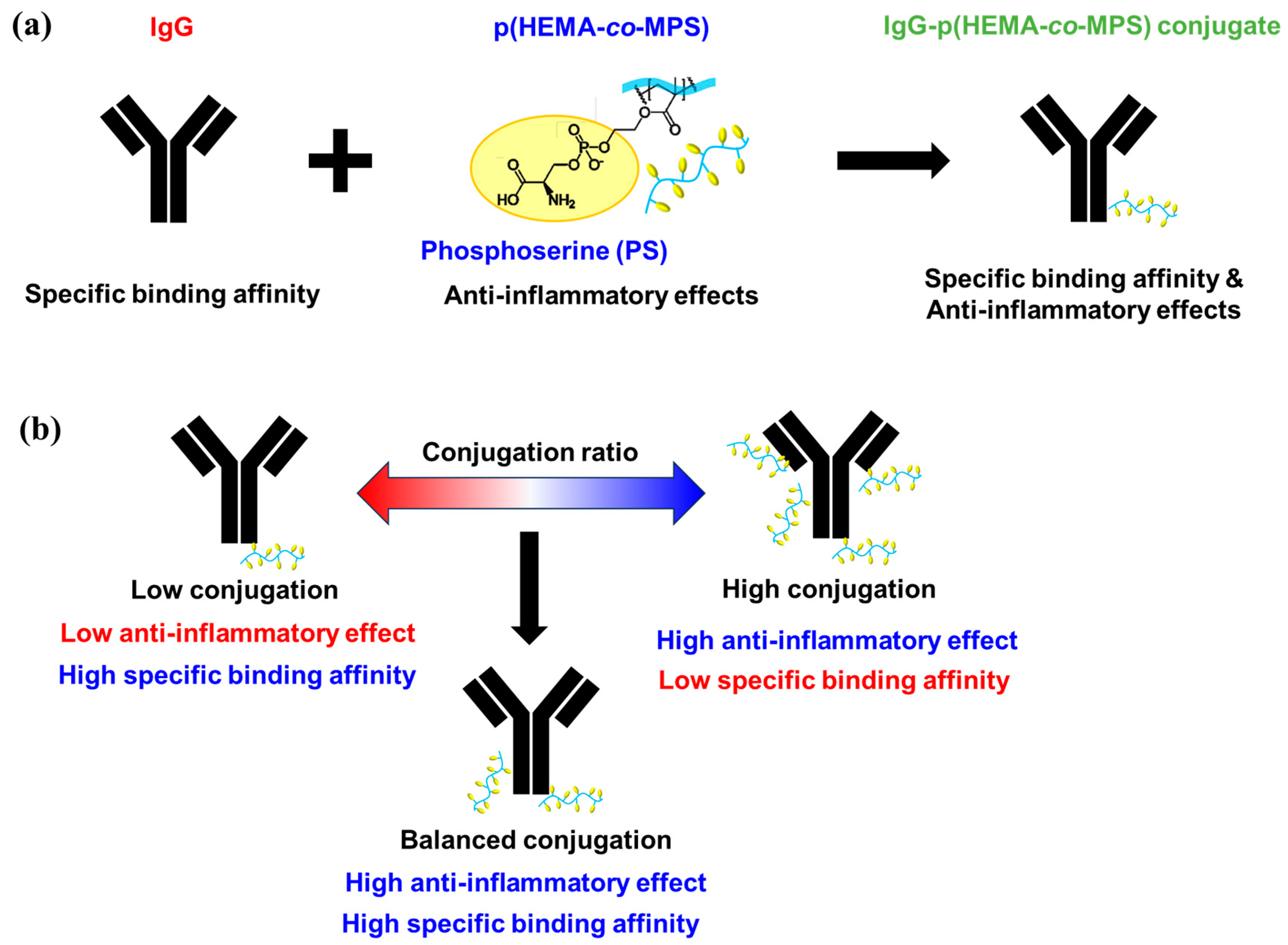
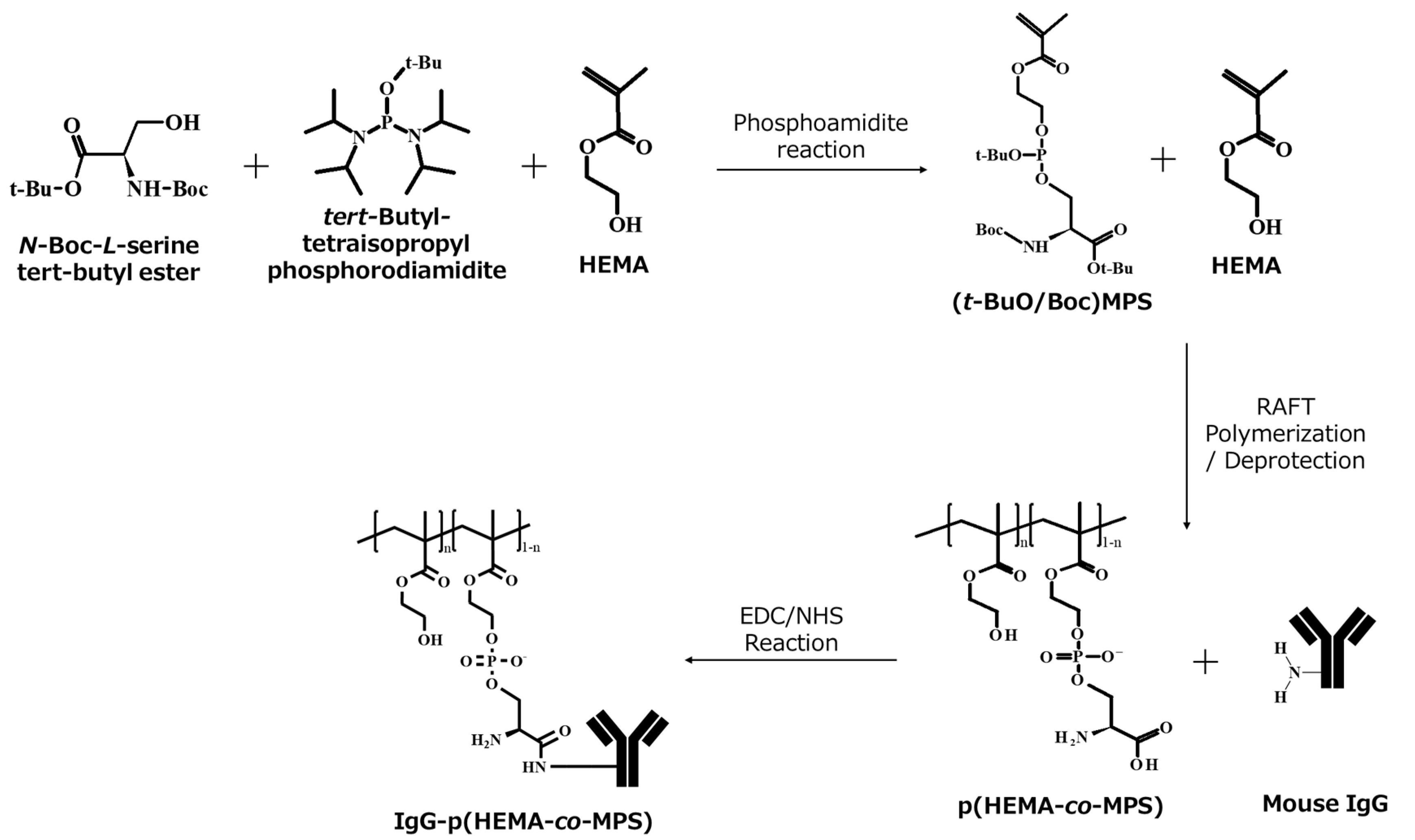
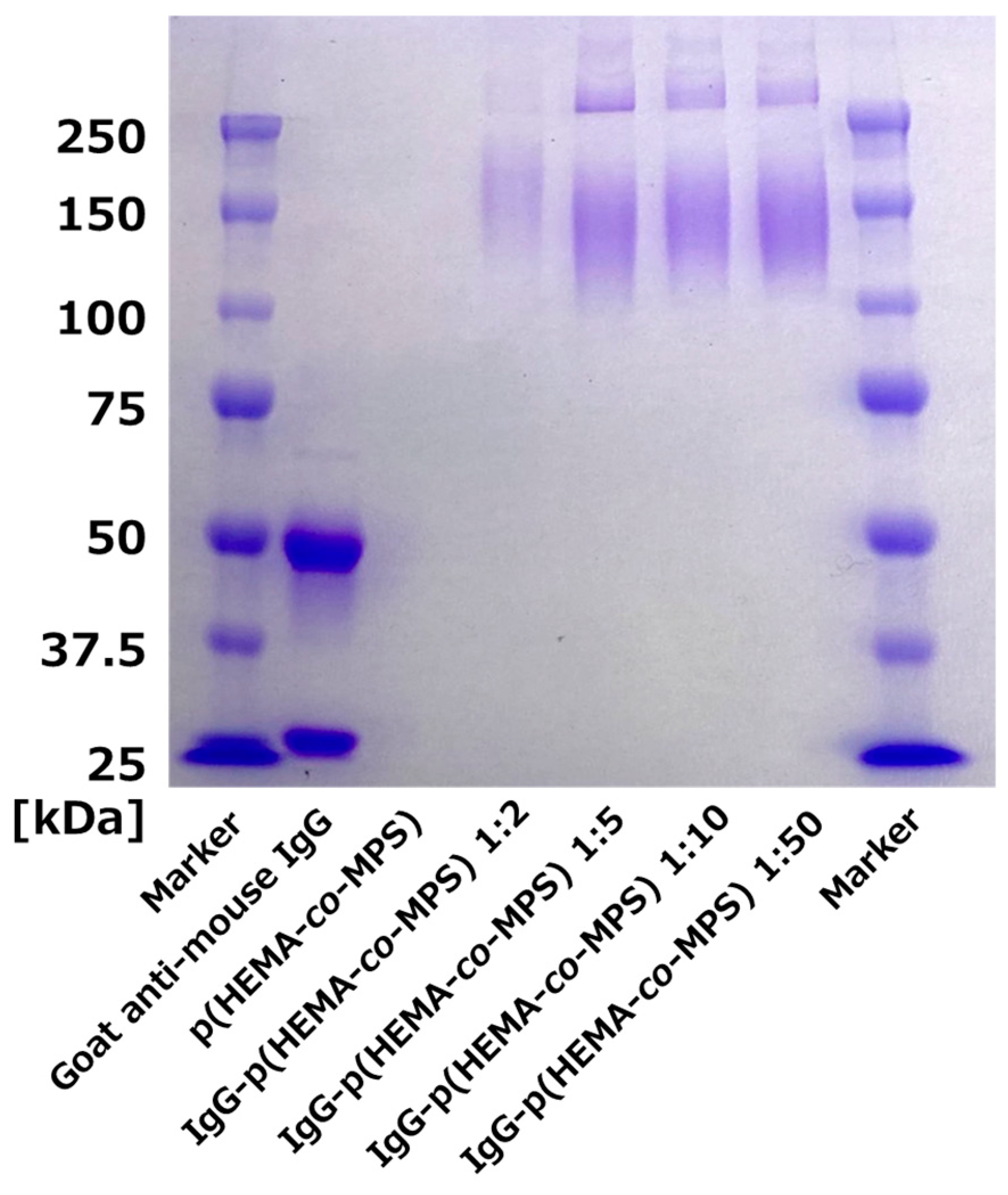

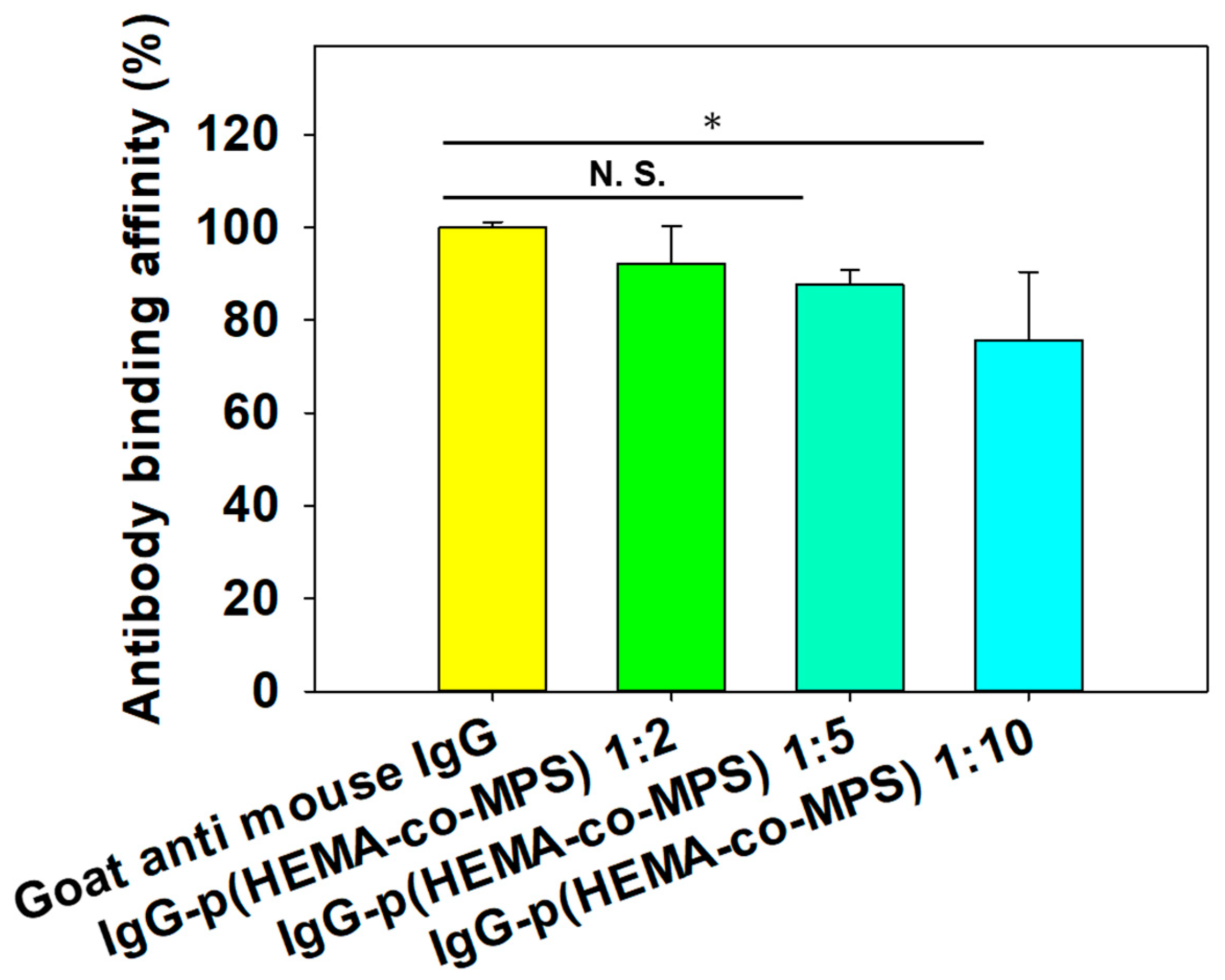
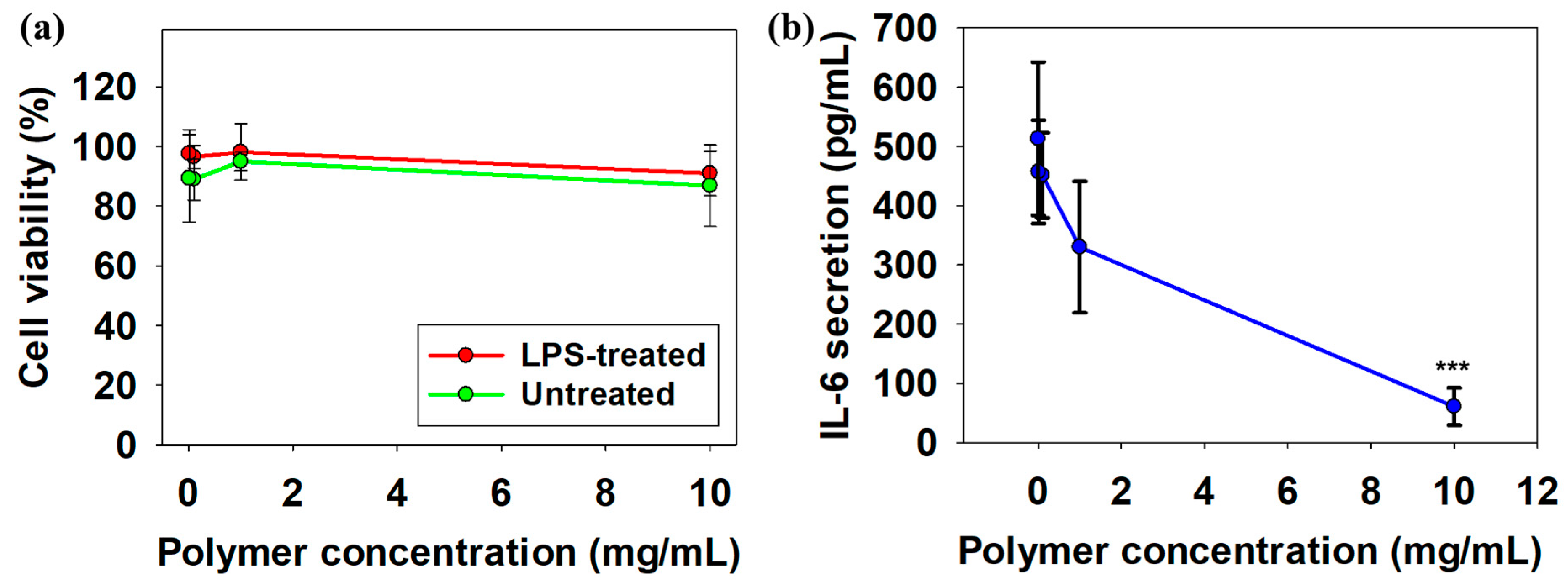
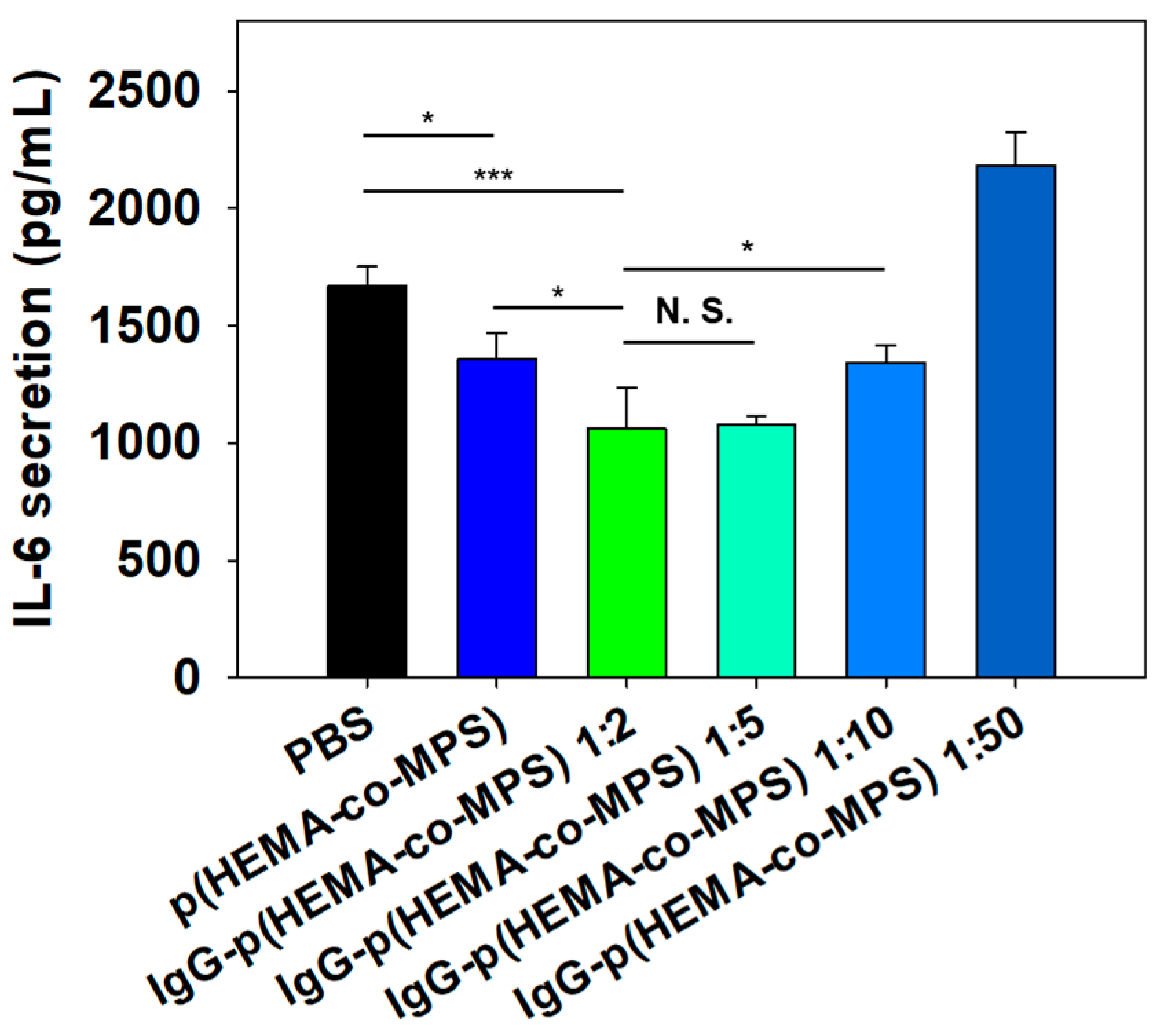
| Mn (kg/mol) | Mw (kg/mol) | Mw/Mn | |
|---|---|---|---|
| Free-radical polymerization | 194 | 410 | 2.1 |
| RAFT polymerization | 9.5 | 13.5 | 1.4 |
| IL6 | TNF-α | iNOS | CD206 | TGF-β1 | IL10 | |
|---|---|---|---|---|---|---|
| PBS | 1 | 1 | 1 | 1 | 1 | 1 |
| p(HEMA-co-MPS) | 0.8 | 0.8 | 0.5 | 2 | 1 | 2.5 |
| IgG-p(HEMA-co-MPS) 1:2 | 0.8 | 0.8 | 0.8 | 1.4 | 0.7 | 3.6 |
| IgG-p(HEMA-co-MPS) 1:5 | 0.9 | 0.8 | 0.6 | 1.5 | 0.6 | 0 |
| IgG-p(HEMA-co-MPS) 1:10 | 0.7 | 0.6 | 0.6 | 1.8 | 0.5 | 2.5 |
Disclaimer/Publisher’s Note: The statements, opinions and data contained in all publications are solely those of the individual author(s) and contributor(s) and not of MDPI and/or the editor(s). MDPI and/or the editor(s) disclaim responsibility for any injury to people or property resulting from any ideas, methods, instructions or products referred to in the content. |
© 2023 by the authors. Licensee MDPI, Basel, Switzerland. This article is an open access article distributed under the terms and conditions of the Creative Commons Attribution (CC BY) license (https://creativecommons.org/licenses/by/4.0/).
Share and Cite
Lee, G.; Iwase, T.; Matsumoto, S.; Nabil, A.; Ebara, M. Development of Apoptotic-Cell-Inspired Antibody–Drug Conjugate for Effective Immune Modulation. Int. J. Mol. Sci. 2023, 24, 16036. https://doi.org/10.3390/ijms242216036
Lee G, Iwase T, Matsumoto S, Nabil A, Ebara M. Development of Apoptotic-Cell-Inspired Antibody–Drug Conjugate for Effective Immune Modulation. International Journal of Molecular Sciences. 2023; 24(22):16036. https://doi.org/10.3390/ijms242216036
Chicago/Turabian StyleLee, Gyeongwoo, Taishu Iwase, Shunsuke Matsumoto, Ahmed Nabil, and Mitsuhiro Ebara. 2023. "Development of Apoptotic-Cell-Inspired Antibody–Drug Conjugate for Effective Immune Modulation" International Journal of Molecular Sciences 24, no. 22: 16036. https://doi.org/10.3390/ijms242216036
APA StyleLee, G., Iwase, T., Matsumoto, S., Nabil, A., & Ebara, M. (2023). Development of Apoptotic-Cell-Inspired Antibody–Drug Conjugate for Effective Immune Modulation. International Journal of Molecular Sciences, 24(22), 16036. https://doi.org/10.3390/ijms242216036







